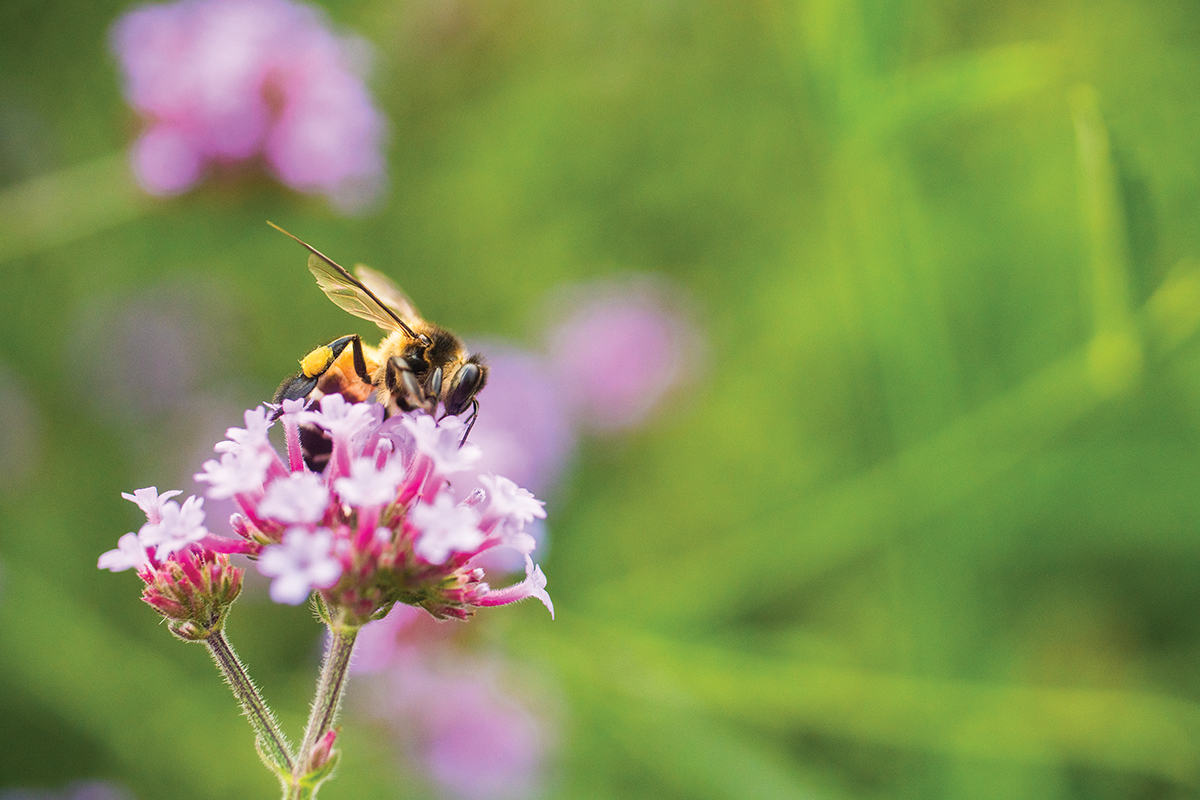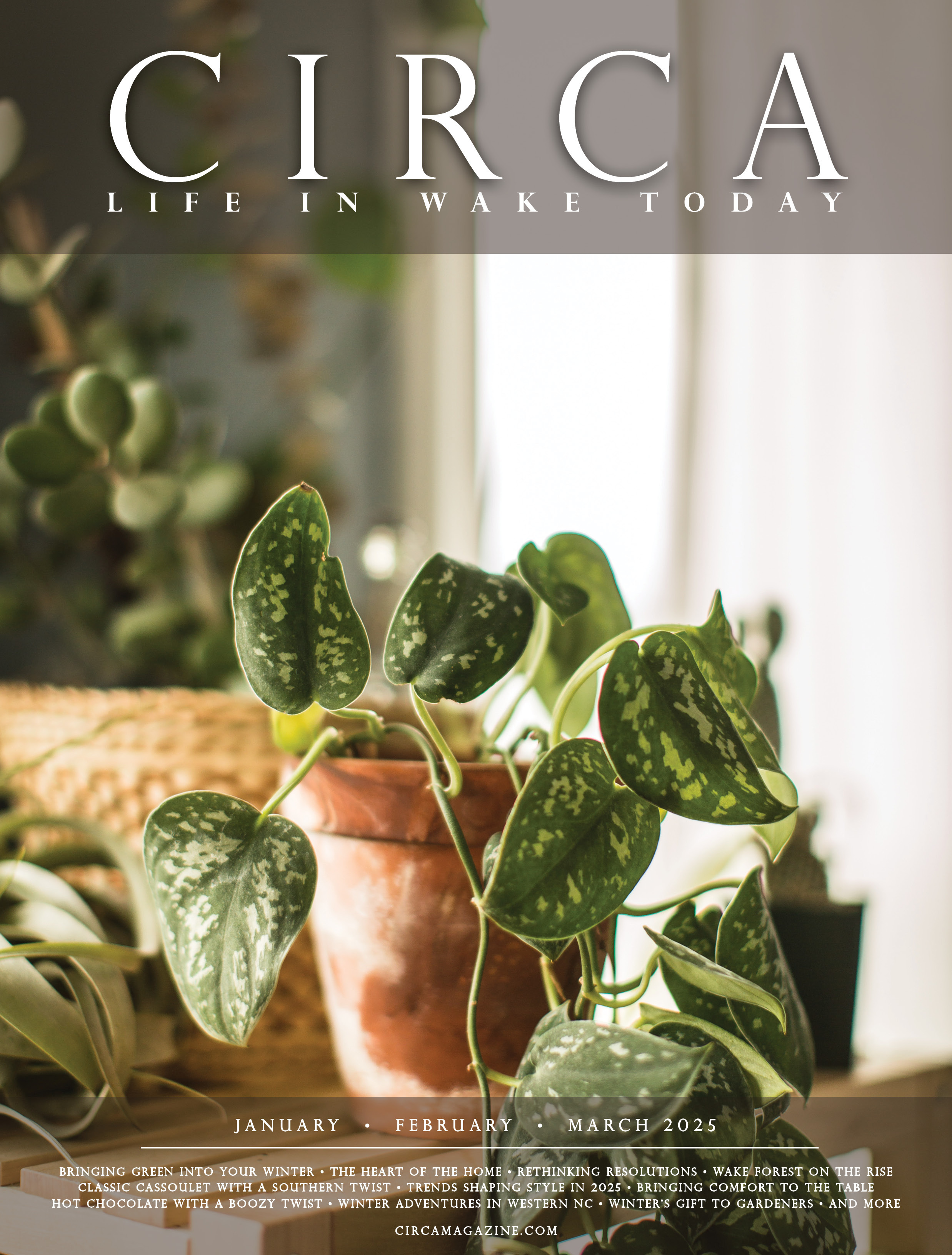What's Best For Bees?
Plant And Habitat Tips For Bees And Other Pollinators

Bees and Colony Collapse Disorder (CCD) have been in the news a lot recently. While the causes of CCD are still being studied and evaluated, we know part of the problem is pesticide use and habitat loss. But, it’s not just about honeybees. There are over 4,000 wild bee species in North America, many of them important pollinators, and they need help, too, as do other pollinators such as bats, birds, and butterflies. Here is a simple guide to get you started in providing a welcoming habitat for bees and other pollinators.
This guide, while not comprehensive due to editorial space restrictions, is a sampling of plants, herbs, shrubs, and trees aimed at the ecoregion known as Southern Mixed Forest, to which most of the Piedmont of North Carolina belongs (for a comprehensive list, visit www.homewoodnursery.com). Plants listed here are often for providing nectar, but also forage (meaning, the insect eats the plant, as with fennel and parsley) and habitat / nesting (as with ornamental grasses). For more information, look up “The Xerces Society” and “Pollinator Partnership” online, as well as the excellent guidebook from The Xerces Society, 100 Plants to Feed the Bees.
Annual Flowers, Herbs, and Vegetables for Pollinators
(An annual dies at the end of the season, as will the following herbs and veggies.)
– Basil: bees, butterflies
– Begonia: hummingbirds
– California Poppy: bees
– Eggplant: bees
– Green beans: bees
– Heliotrope: bees, butterflies
– Impatiens: bees
– Lantana: bees, butterflies
– Marigolds: bees, butterflies
– Morning Glory (vine): bees
– Parsley: butterflies
– Peas / Beans / Legumes: bees
– Petunia: butterflies
– Phlox: bees, butterflies
– Salvia: bees, hummingbirds
– Squash: bees
– Verbena: bees, butterflies
– Zinnias: bees, butterflies
Perennial Flowers and Herbs for Pollinators
– Aster: bees, butterflies
– Black-eyed Susan: bees, butterflies
– Columbine: bees, hummingbirds
– Coneflower (Echinacea): bees
– Daylily: butterflies
– Dianthus: butterflies
– Hellebore / Lenten Rose: bees
– Hollyhock: butterflies, hummingbirds
– Iris: bees
– Goldenrod: bees, butterflies
– Lantana: bees, butterflies
– Lavendar: bees, butterflies
– Lemon Balm: bees, butterflies
– Milkweed / Butterfly Weed: bees, butterflies
– Oregano: bees
– Passionflower: bees
– Phlox: bees, butterflies
– Pink Muhly Grass: bees (habitat)
– Sage (flowering): bees, butterflies, hummingbirds
– Sage (culinary): bees
– Shasta Daisy: bees, butterflies
– Spiderwort: bees
– Sunflower (Helianthus): bees, caterpillar host
– Verbena: bees, butterflies
– Virginia Bluebells: bees
– Wild Indigo (Baptisia): bees, butterflies
– Yarrow: bees, butterflies
– Yucca: hummingbirds
Shrubs for Pollinators
– Abelia: bees, butterflies
– Blackberry: bees, moths
– Blueberry: bees
– Butterfly bush: bees, butterflies, moths
– Chinese Redbud: bees, butterflies
– Citrus: bees, caterpillar host
– Crepe Myrtle: bees, hummingbirds
– Lilac: butterflies
– PeeGee Hydrangea: bees
– Raspberry: bees, moths
– Spirea: bees
– St. Johnswort: bees
– Viburnum: butterflies
Trees for Pollinators
– American Yellowwood: bees
– Flowering apricot, cherry (except Kwanzan), crabapple, plum, peach: bees
– Redbud: bees, caterpillar host
– Magnolia: bees, caterpillar host
– Mimosa: bees, hummingbirds
Gardening Tips for Encouraging Pollinators
– Provide shelter and water in addition to water sources.
– Plant in groups at least four feet in diameter to maximize efficiency for pollinators who can visit many flowers of the same species more easily that way.
– Use as little pesticide as possible, or none at all. Carefully manage pesticides by observing label restrictions and always spray before dawn or at dusk (or after dusk) to avoid times when bees are foraging.
– Minimize soil disturbance (i.e. tilling) to protect groundnesting bees.
– Plant a variety of trees, shrubs, and flowers that bloom at different times, and also those which provide shelter.
– Look for flowers in different colors and shapes which will attract more and different pollinators.
– Leave dead snags and stems of dormant plants for bee nesting sites.
– Incorporate native plants into your landscape. Bees often prefer them to hybrids.
– Provide water via birdbaths, dishes, ponds, etc., with a shallow or sloping side so pollinators may approach without drowning.
– Consider that some types of damage to plants are made by pollinators gathering nesting material or by the larval stage of a butterfly or moth that pollinates flowers. Perhaps the “15 Foot Rule” can be used in your garden. If you can’t see the damage from 15 or more feet away, consider if you want to try to control it in the first place. Some types of plant damage do not affect the long-term health of the plant. This may allow you to forgo pesticides more often.
– Amend or top dress garden beds with plenty of organic matter and compost to encourage healthy plants with plentiful blooms.
– Butterflies love mud puddles which provide them with essential nutrients. A birdbath can also be used.
– Pieces of fruit left out will also attract butterflies.
– Early-blooming plants help pollinators through the lean part of the year when spring is coming. A succession of flowering plants that lasts from spring through fall will support a range of bee species.
Tina Mast
Communications director at Homewood Nursery in Raleigh.
- info@homewoodnursery.com
- www.homewoodnursery.com
- 919-847-0117

